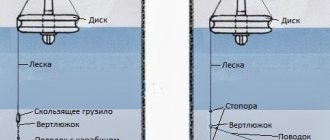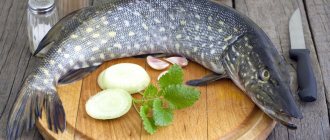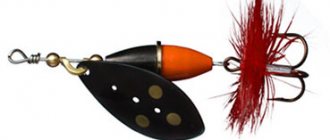I am sure that at least somewhat experienced spinning anglers understand that wiring and the style of presenting the bait greatly influences the effectiveness of fishing. When fishing with modern soft baits, edible silicone, this rule also applies. It is very rare that banal uniform wiring in the upper layers of water, as beginners do, brings at least some result. So let's talk which wiring is better for different types of silicone baits, which wiring techniques better for perch, pike, pike perch and other popular fish species.
Any bait animation of any value is heterogeneous, consisting of different phases. Remember this very well! No matter what class of spinning tackle you use, from heavy jig to ultralight, no matter what type of bait you use, it is very rare when a simple even retrieve gives a good result. If you manage to catch fish on it, it is mainly pike at peak activity. And even then, if you include other elements in the uniform wiring, it will only be better. Moreover, significantly!
Perhaps the only exception is fishing with rotating spoons in shallow streams with a rocky bed. There really is no time for pauses here, and stretching and acceleration do not make sense. But on the pages of this blog we talk mainly about fishing with silicone baits and jigs. And here, the rule of various postings always works.
Well, I will divide this material into two parts. First, I will consider a number of the most popular elements of silicone bait wiring, which make up the complete pattern of its presentation to the fish. In the second part, I will try to describe examples of effective fishing for different types of fish (perch, pike, pike perch, etc.). At a minimum, I’ll tell you what wiring I use. Let's get started.
Uniform wiring.
You cast the bait, give it a pause so that it sinks to the bottom, into the water floor, or we start retrieving right away if we want to bring the bait near the surface.
The rod can be in different positions. The average is parallel to the horizon. Here the depth of the wiring will depend, first of all, on the speed of rotation of the coil. If you want to bring the bait closer to the surface, lift the tip of the spinning rod up. And, on the contrary, if they want to move the bait closer to the bottom (which is most often required), then they lower it to the water itself.
Rotate the reel smoothly and evenly. This will be uniform wiring. If we rotate the reel handle too quickly, our bait will come at us with a rise to the surface. If you rotate it very, very slowly, the bait will gradually bury itself until it falls to the bottom. Well, you can achieve an intermediate option when the bait moves strictly horizontally.
This is the wiring style most commonly used with active silicone baits. Those. with those that have their own game, vibration. It is practically not used with passive baits, since in this way you will not get any interesting game from them.
The wiring is uniform with pauses, “Stop & Go” . This is a more diverse and interesting variation of uniform wiring. Everything is the same as described above, only periodic stops and pauses are made in the rotation of the coil. The bait, at these moments, under the weight of the jig sinker, is directed to the bottom.
Some soft baits, when falling, perform interesting oscillations, playing with their limbs and the entire body. So, it is not surprising that many bites occur during the pause.
Naturally, pauses can interrupt uniform wiring at different frequencies. In fact, pause retrieving is the simplest type of step retrieving, when only the reel is involved, and the rod is not involved in the animation process. So, you can interrupt the rotation with the handle, literally, twice per full revolution, or you can make one or two pauses during the entire wiring.
Also, the duration of pauses in wiring may vary. The bait may only sink a little, or it may completely fall to the bottom and lie there for a little longer until the fish comes up.
So, already with such a simple retrieve as a uniform retrieve with pauses, you can change the game very widely, just by controlling the duration and frequency of pauses.
Retrieving irregularly along the bottom . You can move the bait not only, and not so much, by rotating the reel, but by twitching and tossing the rod. We cast it, let the bait fall to the bottom (the cord sags, or we hear the weight touching the bottom tactilely, “in the hand”). We take out the slack, if there is any. We make a slight upward swing with the rod, lifting the bait from the bottom. Then, pause. We pick up the slack with the reel, and the bait, having reached the top point of the jump, falls to the bottom again. Such jumps can be sharp or smooth, occur with greater or less frequency, and the height and length of the jumps may differ. In the end, you can do whole series of twitches in a row. Two or three twitches, then a pause. You can alternate series with different numbers of jerks. One-one-one, or one, one-two, one, one-two-three, one, one, one-two.
Jig rigs go very well with passive types of baits. But with active ones, with vibrating tails and twisters, this technique should also be practiced.
Wave-shaped wiring . To make the trajectory of the bait in the water column resemble a sinusoid in shape, you can use two techniques. One is the smooth lowering and raising of the tip of the spinning rod during uniform reeling with the reel. The second is a change in the speed of rotation of the coil, with the tip in a stationary position. The rotation slows down and the bait falls down, speeds up and soars up.
This is also a good way to diversify uniform wiring. Also, this method is best with active baits - vibrotails and twisters.
Dragging along the bottom . The fish are accustomed to picking up food from the bottom of the reservoir. So, the bait lying on the bottom during a pause is good! It is also very interesting when the bait moves slowly and drags along the bottom. At the same time, the limbs of the bait and its entire body move nicely. Dragging is especially important for soft baits such as crayfish, cuttlefish, nymphs, and worms.
Of course, the drawing can simply be uniform, obtained by very slow rotation of the reel with the tip of the spinning rod lowered to the water. But, it is better to use drawing with pauses. They dragged it, stopped, dragged it again.
When dragged, the hinged weight plows the bottom, raising a cloud of suspension. So, the fish, which is focused on searching for bottom food, will notice the movement from a distance and attack the bait.
Before moving on to the description of specific wiring for different types of fish, you should give advice on how to develop the technique. It is not enough to perceive the information and go to the pond, trying to speculatively play with bait. Tests should be carried out in clear shallow water or in a swimming pool. You should test the main types of baits you use, see how each of them responds to a particular wiring.
Shaking, vibration . In addition to the techniques described above, the silicone bait can be trembled in one place. The slightest trembling of the spinning rod tip is perfectly transmitted to the bait through the sensitive cord. And it shakes normally, flutters, revives its limbs. You can simply move the bait located on the bottom, or you can include an element of trembling and vibration in the animation drawing, superimposing it on any wiring.
Posting bait for perch . Perch does not really like simple, even movement of the bait. Only twisters and vibrotails, which have a high-frequency tail action, are at least somehow suitable for catching a striped predator on a simple uniform. More successful movements of soft bait for catching perch are: uniform with frequent pauses, short, rather sharp jumps. Large perch love intermittent dragging of the bait along the bottom. The use of microvibration, small tremors with the tip of a spinning rod, is one of the important techniques when fishing, specifically for perch.
Posting bait for pike . Pike, unlike perch, on the contrary, accepts uniform bait movement very well. This does not mean that you should fish exclusively this way. But God himself ordered the use of active baits, in particular large vibrotails, and the inclusion of even stages in the wiring pattern.
Retrieving a pike should be quite smooth, measured, phlegmatic, if you like (someone will remember about twitching wobblers... but silicone is not a wobbler). So, the lighter the weight used for installation, the better. In this case, when retrieving evenly with pauses, steps, during the pause the bait will smoothly sink to the bottom - the toothy predator likes this.
So, use a “Stop & Go” retrieve on your pike, with not very frequent pauses, just a uniform retrieve, stepped retrieves and smooth long jumps along the bottom.
Posting bait for pike perch . Pike perch prefers stepwise and jumping bait movement along the very contour of the bottom. Steps, jumps, at the same time, it is better to do medium and short ones. The size of pauses needs to be adjusted, because At this point, pike perch’s taste may change. And in general, I think that pike perch is more picky and capricious about fishing than perch and pike.
Posting a silicone bait for catfish . I noticed that catfish most often attack the silicone bait during a pause, in free fall. Yes, and all the other predators mentioned in the paragraphs above also often attack the bait during the fall. But with catfish, it seems to me that this is even more critical. So, take long, long pauses when trying to purposefully catch catfish when jigging in holes.
Wiring for peaceful fish . Catching peaceful fish with a spinning rod using edible silicone, although it is gaining momentum, cannot yet be considered a fully formed direction. So, this is just a small subjective recommendation. To increase the chances of catching peaceful fish with microjig tackle, you need to use a slow, smooth retrieve, without sudden movements and hysterical trembling, which perch loves.
This is how I see the topic of choosing jig wiring and soft silicone baits.
Source: sedobka.ru
How to fish with oscillating spoons?
Oscillating spoons are considered quite old gear, used for more than one century. This is gear that has undeniable advantages over other fishing equipment.
If you are fishing for pike with a spoon in a strong current at a depth of up to 2 meters, it is best in this case to use bait that is larger in size and of sufficient weight; the lightweight bait is carried away by the current.
You should not use cheap Chinese-made spinners; it is better to use high-quality tackle with sharp domestic-made hooks when catching pike on a spoon.
In a clear reservoir, it is best to use a bait of a natural color that does not repel predators; for muddy, dark-colored water, shiny bright baits are best suited.
Oscillating spoons are divided according to their shape and their movement in the reservoir:
Rotating rig , this type of bait rotates around its longitudinal axis and attracts the attention of pike in clear spring or summer water, free of weeds;
Swinging bait , this type of fishing tackle swings evenly in different directions, this type of spinner is considered the most catchy when fishing for pike in the autumn season;
Combined spoons , this type of gear swings and rotates at the same time, they are used at any time of the year;
Triangular oscillating spoons performed well during winter fishing in holes .
Fishing with a spoon. Pike at a long distance. Video
Basic fishing for pike in autumn
The list of basic and popular ones includes uniform, twitching or jerking, ripping, aggressive, demolition or jumping. Each variety is characterized by a special execution technique.
READ Fishing for pike in winter from ice: where to look, how and what to catch. Ice fishing for pike in winter: December, January, February
How to do wiring correctly
| Name | Peculiarities |
| Uniform | Ineffective for pike. There are no active movements, wiring does not attract pike. Used to catch other white predators. |
| Twitching, jerking |
The technique consists of light and smooth movements of the spinning rod horizontally. |
| Riping | The rod is moved in a top-down direction. The advantage of this method is deeper penetration of the bait. |
| Aggressive | The jerks resemble hooking, the bait imitates a fish that is trying to swim away quickly, then returns to its original position with oscillating movements. |
| For demolition | The wiring is carried away by the current. It is important to choose the right weight of the bait so that it does not float up and plow the bottom. |
| Jumping | Jumping movements - sharp twitching of the spinning rod, during which the bait comes off by 5-10 cm. |
The most popular oscillating lures for pike
According to their qualities, the 5 best oscillating spinners include:
Spinner "Atom" , a product very popular since the times of the USSR, is an oscillating artificial bait for catching pike and pike perch. Currently, they are produced by various domestic and foreign companies; the main advantage of the products is their smooth, measured play; they have different colors.
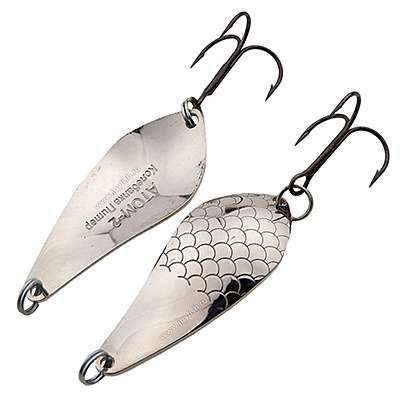
The Blackback spinner is heavy and stands out with its darkened upper part. Such spoons are considered the best oscillating artificial baits in the autumn at depths of three to four meters; they have a small and smooth amplitude of play. The production of such products has been mastered not only in Russia, but also abroad.
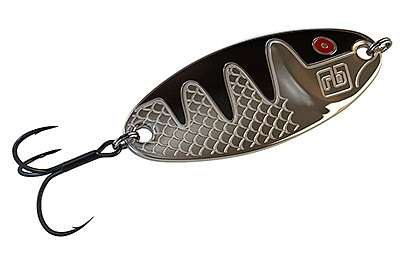
“Colored” spinner , not very common, but quite highly effective artificial bait made in Russia. Outwardly it looks like fish scales, at the end it is equipped with a special red flag made of plastic. It is best to use this tackle at shallow depths.
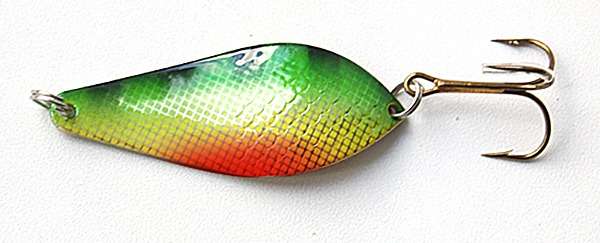
Spinner "Storling" , very popular and one of the oldest oscillating spinners. It is excellent to catch pike with such artificial bait in spring and autumn; do not use it when there is a strong current in the reservoir.
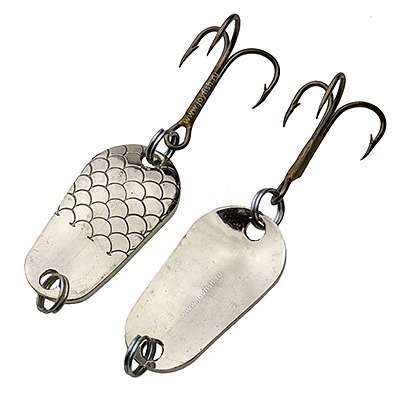
Large-sized spinner “Baltika” , the production of this bait was mastered during the USSR. It is considered the best spoon for catching pike and is colored red and green. Catching pike with a Baltika lure is effective at shallow depths, and its colors attract predators from great distances.
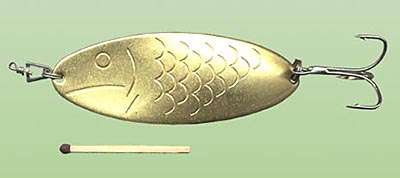
Top 10 best oscillating lures for pike. Video
Looking for big pike
The minimum size of pike allowed for catching is 35 cm. Such individuals are called “pencils” or “shurogags”. Predators are considered large, with body size starting from 1 m and weight starting from 7 kg. To reach this size, a pike needs to live 7-10 years.
Reference! The largest specimen in our country was caught in 1930 in the waters of Lake Ilmen (Novgorod region). The pike weighed 34 kg.
READ is not a workout, but fishing for the soul. pike 7kg
Fall is the perfect time to find big fish. Such individuals are selective in their habitat and feeding habitat. Trophy specimens are solitary: they do not live or feed with “pencils” or young fish.
It is unlikely to encounter a large pike in shallow water. Such predators prefer deep-sea areas:
- deep holes at the bottom, whirlpools;
- channel channels on the river;
- places where tributaries flow;
- crevices and gorges at the bottom;
- deep creeks;
- sunken trees, snags.

There are high chances of catching a large pike in a large and deep area - a river, a reservoir, a lake. In small ponds or settling tanks (maximum depth no more than 3 m), it is difficult to catch a predator of decent size. There is a small food supply and a lack of places for shelter or hunting. The maximum possible weight of individuals is no more than 5 kg.
Color of the spinner. What color is the most popular?
When choosing the color of a spinner, you need to remember that there is no specifically recognized color.
You need to select 2 types of bait:
Provocative color shade , it has an irritating effect on the predator; it is green, yellow and orange in color;
Natural colors that imitate natural fry are silver or bronze colors.
Another positive aspect for lure fishing is the presence of a small red flag at the end of the tackle. Provocative colors do not resemble potential victims of the predator, but they act as a strong irritating element, causing an attack by the pike.
3 ways to improve your fish bite!

Over 15 years of active fishing, I have found many ways to improve the bite, and here are the most effective:
1. Bite activator . This pheromone additive attracts fish most strongly in cold and warm water. The Fish Hungry bite activator has proven itself to be excellent - Read more…
2. Tackle with increased sensitivity . You should first familiarize yourself with the features of using a particular type.
3. Pheromone baits . They attract the attention of fish, stimulate hunger and cause a schooling reflex, which allows you to collect a lot of fish in one place.
You can get the rest of the secrets of successful fishing for free by reading my other materials on the site.
3 ways to improve your fish bite!
Over 15 years of active fishing, I have found many ways to improve the bite, and here are the most effective:
1. Bite activator . This pheromone additive attracts fish most strongly in cold and warm water. The Fish Hungry bite activator has proven itself to be excellent - Read more…
2. Tackle with increased sensitivity . You should first familiarize yourself with the features of using a particular type.
3. Pheromone baits . They attract the attention of fish, stimulate hunger and cause a schooling reflex, which allows you to collect a lot of fish in one place.
You can get the rest of the secrets of successful fishing for free by reading my other materials on the site.
The most catchy and popular color of the spinner. Video
Techniques and tactics of lure fishing
Casting
In a quiet body of water, it is recommended to cast in a fan pattern, where each subsequent cast should be further from the previous one. Thus, the optimal fishing point is determined.
On rivers with medium and fast currents, the bait is thrown diagonally.
If there are drifts, various water obstacles and an uneven bottom surface, it is not recommended to wait until the bait is completely submerged, otherwise the likelihood of getting caught increases significantly.
Wiring
The effectiveness of slow and even retrieving has been proven in practice by experienced spinning anglers, but a good catch is also possible with a combined method, in particular, wave-like, stepped and twitching.
The use of wave-like wiring gives positive results when fishing for active pike: acceleration is replaced by deceleration, while the spoon either sinks to the bottom or rises to the surface. It is recommended to maintain an average reeling speed, and use the rod to adjust the reeling itself, lowering or raising it. It is especially rational to use it in the warm season.
For reservoirs with an uneven bottom and an abundance of protrusions, a stepped wiring option . When passing the bait through the hole, stop the wiring, wait for it to sink to the bottom and continue the action with a slight tug.
The twitching method involves uniform retrieving with light twitching of the rod to give the game versatility.
Sweeping
Here you will need manual dexterity and a quick response to a bite: the rod is moved to an angle of 40–60° to reduce the level of resistance of the fish.
The main thing is to prevent the predator from going into dense vegetation, where the risk of snagging the bait is high.
Posting an oscillating spoon when fishing for pike
Catching pike with a spinner spoon is possible in two ways: uniform and uneven fishing.
When fishing for predators in shallow, transparent reservoirs and holes with a clean bottom, after lowering the bait, you need to pause for about thirty seconds to one minute, and then retrieval, this technique is called “Pause”.
Uniform reeling or “pulling” is a method in which the fishing line is reeled in evenly at the same speed, and the end of the spinning rod is in a stationary position, and the depth of the tackle does not change. Uniform wiring allows the fisherman to catch a larger number of pikes at the moment when it hunts the inhabitants of the reservoir.
When the retrieve is uneven or jerking, the fisherman seems to be playing with the predator, provoking it by making jerking movements with the top of the spinning rod to the sides and up.
Pike on oscillating spoons in the fall. Technique for placing a spinner on video
Wobbler wiring technique. Wiring wobblers
Wobbler wiring technique. Wiring wobblers.
Many novice fishermen, having bought a spinning rod, use only the classic wiring of wobblers, without even thinking about the fact that the wiring of wobblers can be different and, depending on the fishing conditions, can play a decisive role in favor of the amount of catch, because the animation of the game depends on the wiring of the wobbler. bait. In this article we will look at the most common techniques for wiring wobblers.
Main types of wobbler wiring:
Uniform
This is the most common wobbler wiring. The fishing line or braid is constantly wound onto the reel, without manipulating the spinning rod. The wiring is similar to that of a rotating spoon. This type of wiring is most often used with wobblers such as cranks, the play of which, in itself, is attractive to the fish and practically does not require additional animation.
STOP and GO
Stop and go, from English - stop and go
This is wiring that is used for all types of wobblers that have their own game. Using a reel, a fishing line or braid is reeled in, with alternating pauses. Several turns of the reel are made, then a pause is made, which depends on the activity of the predator - the more passive the fish, the more pauses are made. While reeling in the fishing line, the wobbler moves, while using its action, then, during a pause, the wobbler stops and it is this moment that most often forces the predator to attack the bait.
You can also use this wiring to adjust the working horizon of the bait. For example: if you have a pop-up wobbler, then during a pause it will float up, and the length of the pause will regulate the height of the wobbler’s rise in the water column, and the speed and force of winding the fishing line can regulate its depth.
Posting with acceleration
This is a variant of the same uniform wiring, when, alternately, the speed of winding the fishing line increases and decreases, while changing the style of play of the wobbler. It is also possible not to change the speed of rotation of the reel, periodically moving the spinning rod in the direction of movement of the wobbler.
This technique of pulling a wobbler is most effective when the wobbler has a different game, which depends on the speed of pulling the bait.
Twitching
Twitching, from English - convulsive, convulsive twitching
This is the wiring of wobblers, in which constant, sharp and short jerks are made with the tip of the spinning rod, while producing a monotonous reeling of the fishing line. The jerks are made at different angles, with different forces and at different distances, which causes the wobbler to deviate to the sides from its axis of movement, giving the bait additional play.
Twitching is considered highly effective if jerks are done with pauses of varying frequency and duration.
It is used most often when using Minnow class wobblers, which create the game of a wounded, frightened fish.
Jerking
Jerking, from English - twitching, jerking
Similar to twitching, jerks are made with the rod, but more forcefully. Jerks need to be alternated with pauses, during which it is necessary to remove any slack in the fishing line or braid. During jerking, the bait not only deviates from side to side, but also makes several oscillations of its own before this if the bait has its own game, or the wobbler goes a considerable distance (left-right or up-down) if it does not have its own game.
I also recommend reading the articles: Classification and types of wobblers. Types of wobblers. Wobblers with a blade Types of wobblers. Wobblers without a blade. Decoding wobbler abbreviations.
If you have any questions or suggestions about the article, write them in the comments. We will answer, add, tell!





